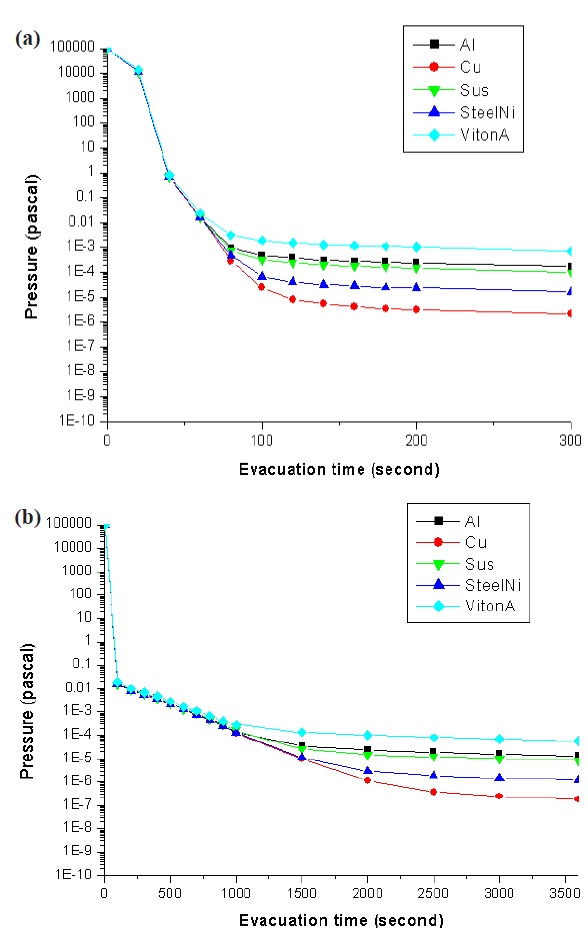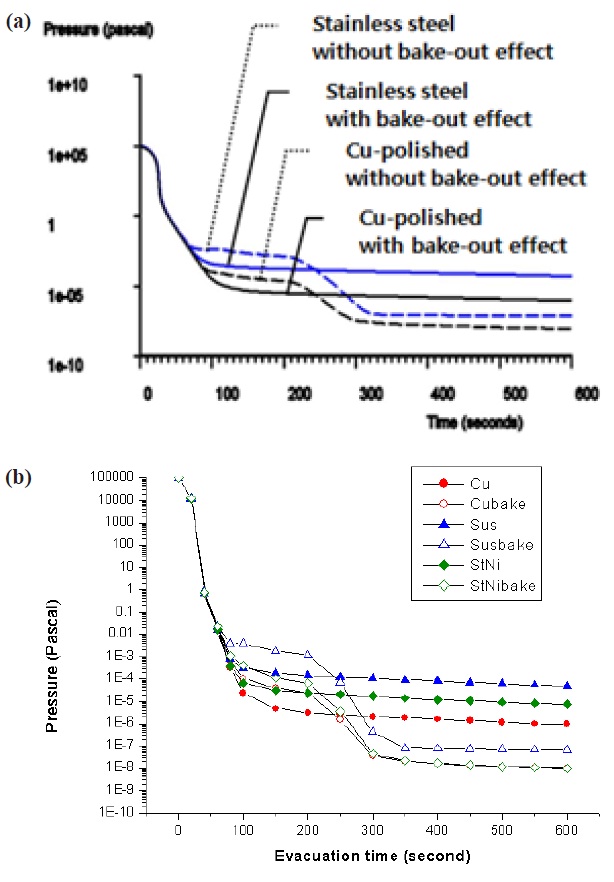



The importance of vacuum techniques has continued to grow with the development of advanced technology. Even greater demands and more stringent conditions are expected to be imposed on vacuum techniques requiring high vacuum qualities. To achieve pressures in the ultra high vacuum (UHV) and especially the extremely high vacuum (XHV) ranges, it is essential to minimize the outgassing from the chamber materials [1,2]. In this work, we simulated the outgassing effects of selected vacuum materials on the vacuum characteristics of modeled vacuum systems. The feasibility of reliably simulating the outgassing characteristics of common vacuum chamber materials was examined in this investigation. Three different UHV systems based on the pumping combinations were modeled by the VacSimMulti simulation tool [12,13]. The outgassing characteristics of stainless steel, anodized aluminum, polished copper, nickel plated steel, and Viton A in the proposed simulation models were examined. Each of the modeled vacuum systems was simulated separately for each of the selected materials with and without the outgassing effects.
The baking effects of the investigated systems and materials on the performance of the vacuum system were also analyzed. The acquired simulation results of the modeled systems and of the probed vacuum materials are plotted in the form of the dynamic pump-down curves.
Three different UHV systems were modeled in this investigation. The most commonly used vacuum systems in materials processing were selected as the modeling systems. Modeling was also performed on the commercial specifications of vacuum systems used in experimental applications. Three different UHV pumping combinations were employed in this modeling with fixed design factors for the chamber, exhaust pipelines, and valves. The simulation design factors of the modeled UHV systems were fixed; the same parameters were used except for the pumping combinations in each simulation. Three different combinations of pumping systems were employed in this modeling, viz. turbo-molecular-rotary, diffusion-rotary, and diffusion-booster-rotary pumps. The proposed UHV systems have a straight pipelines with a length of 0.3 m and a diameter of 0.0254 m. The valves which were employed had internal aperture areas of 5×10-4 m2 and 5×10-3 m2 for rough and high vacuum pumping, respectively, and were normally closed in the absence of a signal. The chamber volume of the modeled UHV systems was fixed at 15 liters. The commercial specifications of the employed pump models are summarized in Tables 1 and 2. The pump models were selected after repetitive simulations to obtain the optimum system modeling. The simulation schematic of one of the modeled UHV systems without outgassing effects is illustrated in Fig. 1.
2.2 Simulation without outgassing
The simulation results of the three different modeled UHV systems without outgassing effects are shown in Fig. 2. The pumpdown curves showed that all three of the modeled systems reached the UHV pressure of 10-7 Pa. As expected, the evacuation time of the turbomolecular pump (TMP) system required to achieve the UHV pressure was considerably shorter than that of the diffusion pump (DP) systems. The evacuation time for the TMP system to reach 10-7 Pa. was less than 4 minutes. After an evacuation time of more than 43 minutes, the DP system without a booster pump attained the UHV pressure. The simulation of the booster pump application also showed better characteristics in terms of both the ultimate pressure and evacuation time of the DP system. Based on the comparison of the commercial specifications with the obtained pump-down characteristics of the pumping systems, it was concluded that the simulation of the modeled systems provides useful results that could be applied to vacuum system design in practice.
2.3 Simulation with outgassing
The simulation schematic with outgassing effects of the DP system is illustrated in Fig. 3. All of the models with outgassing were also simulated to compare the outgassing behaviors of the systems. The outgassing characteristics obtained
2.4 Simulation of outgassing characteristics of vacuum materials
The outgassing of the chamber materials places a limitation
[Table 1.] Commercial specifications of employed turbomolecular pump (Edwards Ltd.).
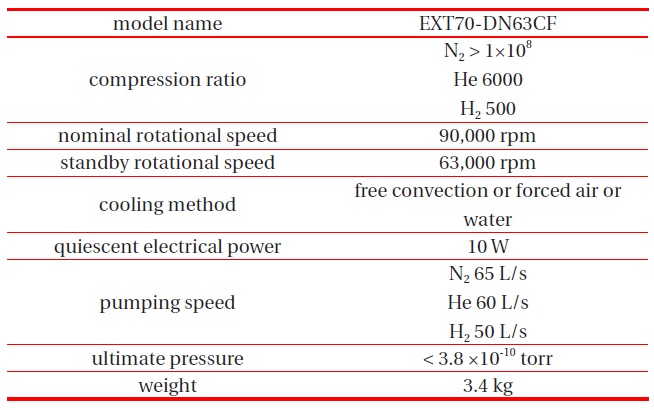
Commercial specifications of employed turbomolecular pump (Edwards Ltd.).
[Table 2.] Commercial specifications of employed rotary mechanical pump (Edwards Ltd.).
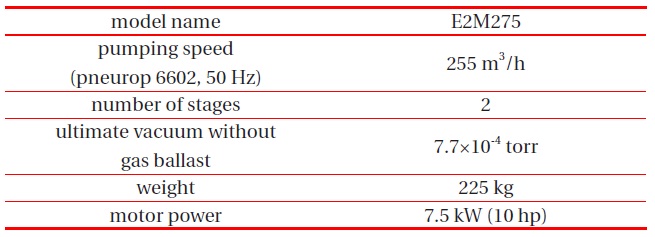
Commercial specifications of employed rotary mechanical pump (Edwards Ltd.).
on attaining very low pressures in UHV systems [3-5,11]. The simulation results of the outgassing characteristics of the selected vacuum materials are illustrated in Fig. 5. The VacSimMulti simulator supports the five different materials which are commonly
[Table 3.] In-situ simulation data of vacuum materials plotted as pump-down curves in Fig. 5.

In-situ simulation data of vacuum materials plotted as pump-down curves in Fig. 5.
used as vacuum materials in the outgassing model. In the TMP system, an ultimate stabilized pressure in the UHV range (10-5 ~ 10-6 Pa) was observed only in the case of polished copper and nickel plated steel among the studied materials (Fig. 5(a)).
Polished copper showed the lowest pressure of 1.29×10-6 Pa. during the simulation. An appreciable amount of outgassing, which was larger than expected, was noticed in the case of anodized aluminum. The lowest pressure obtained in the case of aluminum (1.04×10-4 Pa.) was approximately two orders of magnitude higher than that obtained in the case of polished copper. Almost no variation in pumping behavior due to outgassing effects was observed within the initial evacuation time of 80 seconds in the case of the probed materials, except for Viton A. However, in the DP systems, all of the investigated materials except Viton A reached the UHV range during the period of simulation (Fig. 5(b)). On average, in the case of the studied materials, pressure was obtained that was one order of magnitude lower compared to the TMP system (Table 3). The substantial differences of the evacuation time required to reach pressures in the low UHV range for both systems came from the different pumping mechanisms. The pump-down curves obtained for this model are fairly consistent with the previously obtained simulation characteristics.
2.5 Simulation of baking-out effects on vacuum characteristics
The baking out of the chamber at high temperature under vacuum is regularly utilized to reduce outgassing in system operations. In the case of most vacuum materials, it is probable that the higher the bake-out temperature the lower the subsequent outgassing rate [6-8]. The baking out effects of the studied materials on the outgassing were also simulated in the proposed models. The simulation curves of the TMP system are illustrated in Fig. 6. The bake-out temperature was limited to 160℃. It has been reported that, above this temperature, no significant reduction in outgassing is noticed in the case of stainless steel [9,10]. In the baked-out TMP system, a pressure in the UHV range (1×10-5 Pa.) was reached with anodized aluminum, which was not achieved without baking out. The evacuation time of Ni plated steel required to reach the UHV region was considerably decreased by baking out (483 seconds→236 seconds : Fig. 5(b)). However, in the high vacuum region, almost no reduction in the evacuation time was obtained by baking out. Due to the instant gas release behavior of these materials, anodized aluminum and stainless steel even showed deteriorated characteristics in this range. A low pressure in the UHV range was obtained for the DP systems by baking out with all of the investigated materials except Viton A.
To study the reliability and feasibility of using simulation, three different UHV systems were modeled. Also, in order to confirm the consistency of the simulation results, each of the three modeled systems was simulated separately for each of the studied materials without and with outgassing effects. Only the optimum simulation results, which were obtained after numerous repetitive simulations, were illustrated in the figures and tables. The obtained simulation results are plotted in the form of
the TMP system than in the DP system. An ultimate pressure in the UHV range could not be reached in the TMP system without the prior baking out treatment of the materials employed. The simulation also indicated that the utilization of a booster pump would have a greater effect on the evacuation time than on the ultimate pressure. A considerable decrease of the evacuation time was observed in the case of the booster DP system with outgassing. An ultimate pressure as low as 10-5 Pa. was achieved in the outgassing model of both DP systems. The simulation also suggested that polished copper would be a better candidate as a vacuum chamber material than the other materials to minimize the outgassing. This work indicated that the polishing treatment of copper for vacuum applications could be a useful topic for further research. The appreciable outgassing and slight baking out effect of anodized aluminum on the ultimate pressure showed that the simulation results were in agreement with the previous works [10]. To simulate the overall performance of vacuum systems, it is necessary to consider the tolerance of all of the design factors. However, the present preliminary study enabled us to evaluate the feasibility of using simulation for studying vacuum systems in a reliable manner.


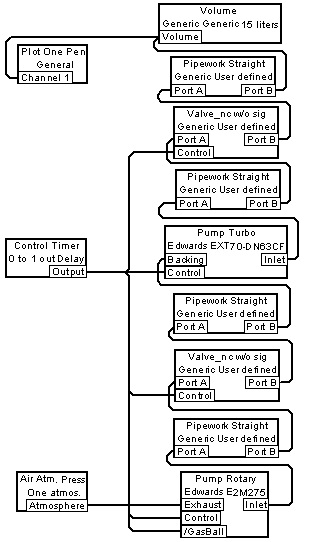
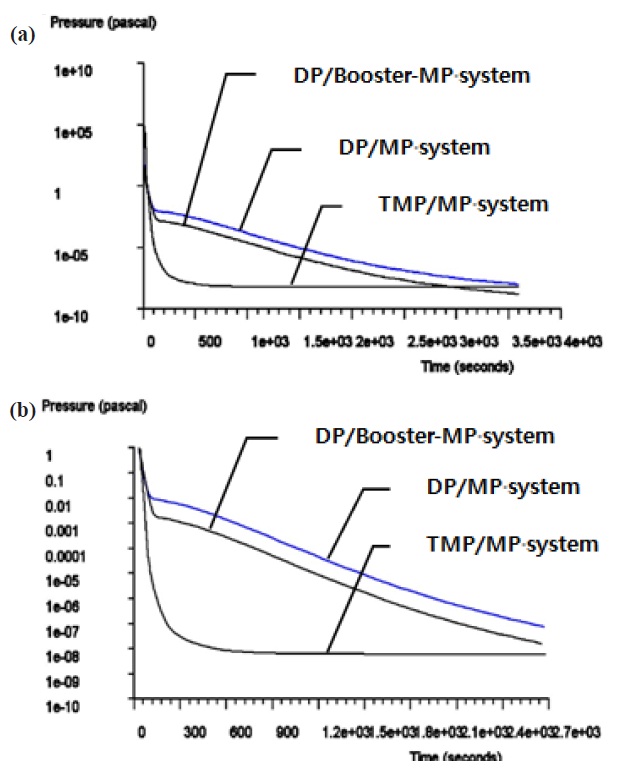
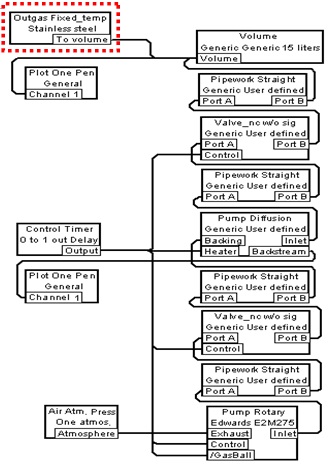
![Comparison of simulation results with and without outgassing effects of modeled systems [(a)TMP-MP system and (b) DP-MP system
without booster pump].](http://oak.go.kr/repository/journal/12807/E1TEAO_2013_v14n6_334_f004.jpg)

